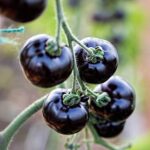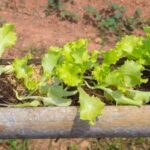In today’s increasingly digital world, photographs have become a powerful medium for showcasing the beauty and diversity of our surroundings. When it comes to vegetable gardens, capturing their splendor through captivating photos has become an art form in its own right. From lush greenery to vibrant produce, these images serve as a visual feast for gardening enthusiasts and inspire others to embark on their own horticultural journeys.
Vegetable gardening is experiencing a surge in popularity as more people recognize the joy and satisfaction that comes from growing their own food. Whether it’s a small balcony garden or a sprawling backyard oasis, these edible landscapes have taken center stage in many households. And what better way to appreciate their aesthetic appeal than through stunning photographs that capture their essence?
Visual representation plays a crucial role in conveying the charm and productivity of vegetable gardens. It allows us to experience the intricate details of every leaf, flower, and harvest up-close, highlighting the rewards of careful cultivation. In this article series, we will delve into the art of vegetable garden photography, showcasing breathtaking images that celebrate both the artistic aspect and nurturing spirit of these productive spaces.
Stay tuned as we take you on a virtual tour through captivating photographs of vegetable gardens-exploring their unique challenges, offering tips for stunning shots, documenting growth journeys from seed to harvest, showcasing innovative designs, creative arrangements, enchanting interactions with wildlife, and providing inspiration for your very own garden dreams. Get ready to be inspired by the beauty and bountiful potential of vegetable gardens captured in every frame.
The Art of Vegetable Garden Photography
When it comes to photographing vegetable gardens, there are unique challenges and opportunities that arise. The goal is to capture stunning shots that showcase the beauty and productivity of these gardens. To achieve this, there are several tips and techniques that can be employed.
- Finding the right angles: One of the key elements in capturing captivating photos of vegetable gardens is selecting the right angles. Experiment with different perspectives – get down low to capture close-ups of vibrant plants, or find a high vantage point to showcase the entire garden layout. Play around with different angles to find what works best for each specific scene.
- Harnessing lighting: Lighting is crucial in photography, and vegetable gardens provide a range of lighting conditions throughout the day. Take advantage of natural light during golden hour (the hour after sunrise or before sunset) when it creates a warm and soft glow. Overcast days can also offer diffused lighting that brings out the colors in plants without harsh shadows. Avoid shooting in direct sunlight as it can wash out colors and create unflattering shadows.
- Macro photography: Macro photography is perfect for capturing intricate details in vegetable gardens, such as water droplets on leaves or tiny insects hovering around blooms. Invest in a macro lens or extension tubes to get up close and personal with the delicate features found within these gardens.
Remember, practice makes perfect when it comes to vegetable garden photography. Don’t be afraid to experiment with different settings on your camera or smartphone, try out various compositions, and learn from both successful shots and those that didn’t quite turn out as expected.
Overall, capturing stunning shots of vegetable gardens requires patience, creativity, and an understanding of the unique aspects these gardens offer in terms of angles and lighting. By following these tips and techniques, you will be well on your way to creating beautiful visual representations that showcase the true artistry of vegetable gardens.
Breathtaking Gardens in Full Bloom
Vegetable gardens are not only a source of fresh produce but also a feast for the eyes. In this section, we will showcase a series of visually stunning and vibrant vegetable gardens that will leave you in awe. These gardens boast an array of colors, textures, and tightly packed produce that create a mesmerizing sight.
One garden that captures the essence of beauty is a kaleidoscope of colors, with rows upon rows of vibrant vegetables. From deep purple eggplants to bright red tomatoes, each plant stands out against the backdrop of lush green foliage. The variety in hues creates a visual spectacle that showcases nature’s extraordinary palette.
Texture is another element that adds depth and intrigue to vegetable gardens. In one photograph, you can see an assortment of leafy greens with their different shapes and sizes – the serrated edges of lettuce leaves contrasting with the smooth surface of spinach leaves. The presence of both smooth and rough textures creates an artistic composition in these edible landscapes.
The tightly packed produce in these gardens is evidence of their productivity and abundance. Carrots peeking through the soil show promise for future harvests while cornstalks tower above neighboring plants. These images convey not only the visual appeal but also the potential for nourishing meals that can be created from these bountiful spaces.
Capturing these breathtaking gardens in full bloom requires skillful photography techniques. Finding the right angles to showcase the beauty and maximizing natural lighting are essential elements to consider when capturing vivid photos. By experimenting with various perspectives and manipulating light, photographers can bring out the best in these splendid vegetable gardens.
Whether you have your own vegetable garden or simply appreciate their beauty, these vibrant photos serve as inspiration for all garden enthusiasts. They remind us of the joy and fulfillment that come from witnessing nature’s artistry at its finest. So take a moment to immerse yourself in these captivating images, as they showcase just how picturesque vegetable gardens can be.
From Seed to Harvest
Vegetable gardens are a labor of love, requiring dedication and patience as gardeners nurture their plants from seed to harvest. Documenting this growth journey through photography allows us to capture the magic of the process and celebrate the fruits of our labor. In this section, we will delve into the importance of documenting the growth stages of vegetable gardens and share some tips for capturing captivating photos.
The Magic in Seeds
The journey of a vegetable garden begins with a tiny seed, bursting with potential. Capturing photos that showcase this starting point can be incredibly rewarding. Close-up shots of seeds being planted in nutrient-rich soil or delicate sprouts emerging from the ground create a sense of anticipation and excitement. These images serve as a reminder that every bountiful harvest starts with a single seed.
Nurturing Growth
As the seeds grow into sturdy plants, documenting their progress allows us to witness nature’s marvels firsthand. A series of sequential photos, taken at regular intervals, can showcase the development of various vegetables – from the emergence of leaves and stems to the formation of buds and blossoms. By capturing these stages, we gain a greater understanding and appreciation for each plant’s unique growth patterns.
Harvest Time
The moment when it’s time to harvest is perhaps one of the most satisfying aspects of vegetable gardening. Photographing baskets overflowing with freshly picked produce or hands reaching for ripe tomatoes evokes a sense of accomplishment and fulfillment. These images not only document the literal fruition of our hard work but also serve as inspiration for future seasons.
Innovative Designs and Layouts
When it comes to vegetable gardens, there is no one-size-fits-all approach. Whether you have a spacious backyard or a small balcony, there are countless innovative designs and layouts that can inspire your own vegetable garden. In this section, we will showcase a range of vegetable garden photos that demonstrate the versatility of different designs.
One design that has gained popularity in recent years is the compact vertical garden. These gardens utilize vertical space by growing plants on trellises or other structures, making them ideal for those with limited ground space. The photos of these gardens feature lush greenery climbing up walls or fences, showcasing how even the smallest spaces can be transformed into thriving vegetable gardens.
Raised beds are another popular design choice as they offer several advantages such as better soil drainage and easier access for gardening tasks. Our collection of photos showcases various raised bed designs, from sleek and modern to rustic and traditional. These photos highlight the neat rows of vegetables growing in raised beds, creating an organized and visually appealing aesthetic.
For those who lack outdoor space altogether, container gardens provide a creative solution. Our photos display vibrant containers filled with an array of colorful vegetables, demonstrating how creativity can flourish within limited confines. These container gardens can be placed on balconies, patios, or even windowsills, making them accessible to anyone with a little bit of sunlight.
Regardless of the available space you have, there is no shortage of ideas to inspire your vegetable garden design. It’s important to consider factors such as sunlight exposure, nearby trees or buildings that may cast shadows, and accessibility for maintenance. By exploring different designs through these captivating photos, you will find inspiration to create your own unique vegetable garden that suits your needs and preferences.
Curated Beauty
Creating visually striking arrangements
In the world of vegetable gardens, beauty isn’t limited to the vibrant colors and textures of the plants themselves. Thoughtful arrangements can elevate the aesthetic appeal of a garden, creating a visually striking space that is both functional and attractive. From color block planting to companion planting, there are various techniques that gardeners can experiment with to curate their own masterpiece.
Color block planting involves grouping vegetables together based on their color to create visually pleasing patterns. For example, arranging different varieties of lettuce in alternating rows of reds, greens, and purples can create a stunning visual effect. Similarly, pairing contrasting colors like orange and blue or yellow and purple can make certain areas of the garden pop.
Companion planting takes into account not only color but also plant growth habits and pest deterrence. By strategically interplanting compatible vegetables, you can create a harmonious arrangement that maximizes space while benefitting from symbiotic relationships. For instance, planting taller plants like tomatoes or corn alongside climbing vegetables such as beans or cucumbers creates a vertical element that adds visual interest to the garden.
The benefits of thoughtful arrangements
Beyond their visual appeal, these curated arrangements also have practical benefits for vegetable gardens. Certain combinations of plants help improve soil conditions by adding nutrients or deterring pests naturally. For instance, planting marigolds near tomatoes helps repel nematodes while adding vibrant splashes of yellow and orange to the overall arrangement.
Furthermore, well-arranged gardens provide an organized structure that promotes efficient growth and maintenance. Grouping plants with similar watering or sunlight requirements together allows for more targeted care. Additionally, thoughtful spacing between plants ensures proper air circulation and minimizes the risk of diseases.
Encouraging experimentation and creativity
The artistry of vegetable garden arrangements provides an opportunity for gardeners to unleash their creativity while caring for their plants. Playful experimentation with different combinations and patterns can result in stunning gardens that reflect the gardener’s unique style and taste.
Whether you opt for a symmetrical layout or a more whimsical arrangement, remember that it’s important to consider both functionality and aesthetics. By creating visually pleasing arrangements that also support the growth and health of your vegetables, you can achieve an enchanting vegetable garden that is a testament to your creativity and care. So go ahead and let your imagination run wild as you curate the beauty of your own vegetable garden.
Enchanting Garden Wildlife
Vegetable gardens are not only a source of fresh produce and a beautiful addition to any outdoor space, but they also attract a variety of enchanting garden wildlife. From butterflies and bees to birds and other pollinators, these visitors bring an added element of charm and vibrancy to vegetable gardens. Capturing photos of these wildlife can provide a unique perspective and highlight the interconnectedness between nature and our gardens.
Highlighting the Importance of Garden Wildlife
Gardeners often strive to create an ecosystem that supports biodiversity and attracts beneficial insects and animals. Encouraging garden wildlife is essential for successful pollination, which leads to healthy crops and high yields. By documenting these creatures in photographs, we can not only celebrate their presence but also raise awareness about the importance of creating a welcoming environment for them.
Tips for Capturing Photos of Enchanting Garden Wildlife
Capturing photos of garden wildlife can be challenging due to their quick movements and unpredictable behavior. However, with some tips and techniques, you can increase your chances of capturing stunning shots. Here are a few suggestions:
- Be patient: Spend time observing the patterns and habits of the wildlife in your garden. This will help you anticipate their movements and capture them in action.
- Use a zoom lens: To get up-close shots without disturbing the creatures or risking their safety, invest in a quality zoom lens.
- Set up feeding stations: By providing food sources like nectar-filled flowers or bird feeders near your vegetable garden, you can entice wildlife to stay longer while you snap some pictures.
- Practice stealth: Move slowly and avoid sudden movements that might startle or scare away your subjects.
- Utilize natural light: Take advantage of soft morning or late afternoon light for more flattering photographs.
| Tips for Capturing Photos of Enchanting Garden Wildlife |
|---|
| Be patient: Spend time observing the patterns and habits of the wildlife in your garden. This will help you anticipate their movements and capture them in action. |
| Use a zoom lens: To get up-close shots without disturbing the creatures or risking their safety, invest in a quality zoom lens. |
| Set up feeding stations: By providing food sources like nectar-filled flowers or bird feeders near your vegetable garden, you can entice wildlife to stay longer while you snap some pictures. |
| Practice stealth: Move slowly and avoid sudden movements that might startle or scare away your subjects. |
| Utilize natural light: Take advantage of soft morning or late afternoon light for more flattering photographs. |
Inspiration and Ideas
Using stunning photographs of vegetable gardens can be a valuable resource for anyone looking for inspiration and ideas when it comes to designing and planning their own garden. In this section, we will explore the various ways in which vegetable garden photos can serve as an essential tool in creating beautiful and functional spaces for growing produce.
One of the key benefits of using vegetable garden photos for design and planning is the ability to visualize different layouts and features. By examining a variety of photos, gardeners can get a sense of how different elements, such as raised beds, trellises, or unique watering systems, can be incorporated into their own space. These visual references offer inspiration and help individuals envision how these features could potentially enhance their gardens.
In addition to layout ideas, vegetable garden photos also provide valuable insight into the organization and arrangement of plants. Photographs that showcase aesthetically pleasing arrangements, like color block planting or companion planting, can inspire gardeners to experiment with different combinations and patterns in their own gardens. Thoughtful arrangements not only add visual appeal but also promote plant growth by utilizing space efficiently and deterring pests naturally.
Vegetable garden photos also serve as a guide in selecting suitable plant varieties. By observing photos of successful gardens, individuals can identify specific plants that thrive together or choose varieties that complement one another in terms of color or texture. Additionally, photographs depicting well-maintained gardens can provide guidance on pruning techniques or support systems that are beneficial for certain crops.
Conclusion
In conclusion, the artistry and nurturing spirit of vegetable gardens are beautifully captured through photography. This blog post has highlighted the various aspects of vegetable garden photography, from capturing stunning shots to showcasing vibrant gardens in full bloom.
The journey from seed to harvest has been documented through sequential photos, and different innovative designs and layouts have been showcased to inspire readers to explore their own garden spaces. Additionally, the aesthetic arrangements in vegetable gardens and the enchanting presence of wildlife have been celebrated through captivating photographs.
Through the lens of a camera, vegetable gardens come alive with their vibrant colors, textures, and abundant produce. Each photograph tells a story of growth, patience, and dedication that gardeners pour into their beloved spaces.
From the initial planting of seeds to the bountiful harvest season, these images capture the sense of accomplishment and fulfillment that comes from witnessing a garden’s progress. They serve as a reminder of our connection to nature and the joy that can be found in cultivating our own food.
Furthermore, these photographs inspire us to think creatively about our own vegetable garden designs. The diverse layouts showcased in this article demonstrate the versatility of gardening and encourage readers to experiment with different methods based on their available space and preferences. Additionally, aesthetically pleasing arrangements offer not only visual appeal but also functional benefits such as promoting plant growth and deterring pests.
Finally, wildlife plays an essential role in vegetable gardens, bringing an enchanting element that is both beautiful and beneficial. The photographs featured in this post showcase unexpected visitors such as butterflies, bees, and birds interacting with the garden. By creating a welcoming environment for these creatures through conscious gardening practices, we can contribute to preserving biodiversity while enhancing the beauty of our spaces.
Frequently Asked Questions
What is a good layout for a vegetable garden?
A good layout for a vegetable garden depends on various factors, such as the available space, sunlight exposure, and personal preference. One popular layout is the traditional row style, where plants are grown in straight rows with defined paths in between for easy access and maintenance. Another option is a raised bed layout, which involves building raised beds to create separate planting areas.
This can be beneficial for improving drainage and soil quality. Square foot gardening is another layout that maximizes space by dividing it into square sections and planting different crops within each section according to spacing recommendations. Ultimately, a good layout should consider efficient use of space, accessibility, proper sunlight exposure, and the specific needs of the vegetables being grown.
What vegetables grow well together?
Certain vegetables grow well together due to their complementary characteristics and beneficial interactions. Companion planting is an effective strategy that promotes healthy growth and discourages pests or diseases without relying heavily on synthetic chemicals. For example, planting tomatoes with basil or marigolds can repel insects that are harmful to tomatoes while attracting pollinators like bees.
Beans help enrich soil by fixing nitrogen from the air into a form usable by other plants; hence they are often grown alongside crops that benefit from increased nitrogen levels such as corn or squash. Similarly, carrots can be companion planted with onions or leeks as they help deter pests that may attack carrots. Therefore, it’s important to research the specific companion planting combinations that benefit each vegetable variety.
What are the best veggies to grow for beginners?
When starting out as a beginner in vegetable gardening, it’s best to focus on growing easy-to-care-for vegetables that have a higher success rate. Some of the best veggies for beginners include lettuce and other leafy greens like spinach or Swiss chard since they are quick-growing and forgiving of minor mistakes in care. Radishes are also great as they mature rapidly within a few weeks from sowing seeds, providing relatively instant gratification for those new to gardening.
Tomatoes are another popular choice among beginners due to their versatility, but they require a bit more care and attention. Herbs like basil, mint, or parsley can also be ideal for beginners as they are easy to grow and can be used in cooking. Starting with these vegetables provides a good foundation for gaining gardening experience while enjoying fresh produce.

If you’re looking to get into vegetable gardening, or are just looking for some tips on how to make your current garden better, then you’ve come to the right place! My name is Ethel and I have been gardening for years. In this blog, I’m going to share with you some of my best tips on how to create a successful vegetable garden.





